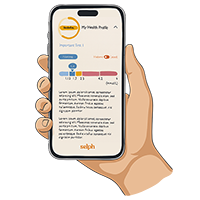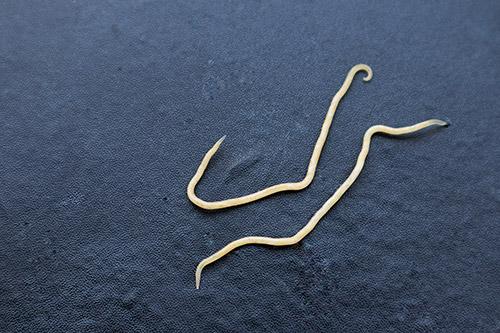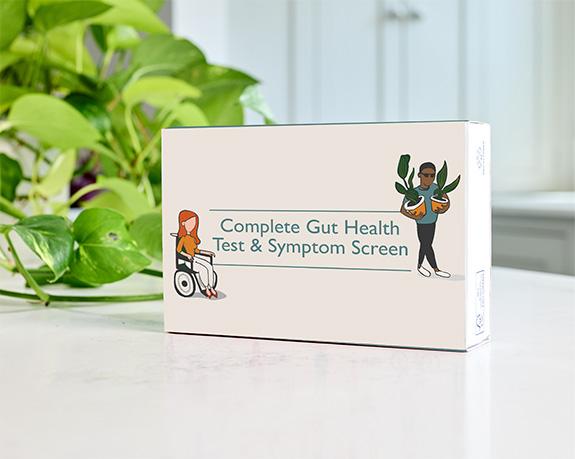Personalise your test
Upgrade to Advanced Gut Bacteria, Worm and Parasite Test
PopularIncluded in Standard test:
- Stool microscopy for worms and parasites (not suitable for pinworms)
- PCR testing for 4 bacteria & 2 parasites
Advanced Gut Bacteria, Worm and Parasite Test includes stool microscopy as for standard plus advanced PCR testing for:
Add to your test
3 add-ons availableTotal price:
£109.00
Includes our
Gut Bacteria, Worm and Parasite Test
Take our Gut Bacteria, Worm and Parasite Test if you're concerned that you may have a bowel infection with a bacterium, worm or other parasite.
Take your stool sample at home and send it to our NHS-testing lab to check for common bacteria, Giardia and Cryptosporidium as well as roundworms, flatworms, tapeworms and other parasites.
What you need to know about our Gut Bacteria, Worm and Parasite Test
Gut infections are a common cause of bowel symptoms such as diarrhoea, stomach pain, bloating and nausea.
Our Gut Bacteria, Worm and Parasite Test checks for common and important gut infections caused by bacteria, parasites and worms. We use highly sensitive DNA-based PCR to test for bacteria and the parasites Giardia and Cryptosporidium. We also use stool microscopy for ova cysts and parasites (OCP), the gold-standard worm and parasite test used to pick up all manner of roundworms, flatworms and tapeworms.
Who gets gut bacteria, parasite or worm infections?
Most gut infections are caused by coming into contact with contaminated food or water. This can include drinking water or recreational water - e.g. swimming in pools, rivers and lakes.
You’re more likely to pick up a parasitic or bacterial gut infection while travelling abroad or if someone you spend time with has also been unwell. A lot of the time, gut infections are over in a few days, but symptoms can last longer with gut parasites. If this is the case for you, it can be worth taking a test to see what’s going on.
How do I know if I have an infection with a gut parasite or worm?
Symptoms and signs of a worm or parasite infection will vary depending on the bug involved.
You might experience non-specific symptoms such as:
- Tiredness and fatigue
- Weight loss
- Rashes
You might notice gut-specific symptoms including:
- Stomach pain
- Bloating
- Nausea
- Diarrhoea
- Bleeding from the bottom
In some cases you can have no symptoms at all.
If I have a worm infection will I see them in my stool?
By far the most common worm infection in the UK is pinworms or threadworms. Nearly 50% of children will pick up threadworms at some point. Threadworms really live in the anus rather than bowel per se. They're small "thread-like" worms up to 10mm or so in length and you can often see them in your stool. The main symptom of threadworm infection is itching of the bottom, particularly at night.
If you suspect threadworm infection because of symptoms or you've seen threadworms in your stool, you don't generally need to test for it. You simply take the treatment mebendazole which is available from your pharmacy.
Infections with roundworms, flatworms and tapeworms are actually very rare in the UK. They nearly all occur in people who have been exposed abroad in coutries where these infections are more common. In cases of roundworm or flatworm infection you may well see worms, worm segments or eggs in your stool.
Limitations of the gut parasite test
It's important to be aware that a stool test is not the best way to pick up pinworms (threadworms) and we don't recommend using it for that purpose. Pinworms are tiny, common but harmless thread-like worms that you can sometimes see in stool. If you can see these worms, the recommendation is usually just to treat them with the over-the-counter medication "Ovex" rather than take a test.
It is very common for people to mistake vegetable matter or threads of mucus in the stool for a worm. Seeing what you think may be a worm in your stool doesn't guarantee that evidence of a worm (eggs for example) will be seen when the sample is examined under a microscope.
Even when you do have a worm or other parasite infection, there is no guarantee that eggs will be present in the sample that's analysed. It's often recommended to examine up to three separate samples under a microscope to rule out some worm infections.
How it works

Do your test
You'll get your kit next-working day.
Collect your sample at home and send it back to our UKAS-accredited lab for analysis.

Get rapid results
We'll let you know when the lab have received your sample for analysis.
You'll get your results and doctor's report in your online dashboard. You'll also be able to download your formal lab report to share with your GP if you wish.

Improve your health
Numbers are useful but it's what you do with them that counts.
We'll give you advice on how to improve your health based on your results. You can also book a consultation to discuss your results with one of doctors (costs extra).
What's tested in the Gut Bacteria, Worm and Parasite Test?
You can choose between our standard and advanced gut pathogen profiles. Both include stool microscopy to examine your stool for worms such as roundworm and tapeworm.
The standard test includes PCR testing for 4 common gut bacteria and 2 parasites. The advanced test includes extended PCR testing for 5 viruses, 4 parasites and 14 bacteria.
Tested in both the Standard and Advanced Gut Bacteria, Worm and Parasite Test
Stool microscopy for Ova, Cysts and Parasites (OCP)
We examine the stool directly and look at it under a microscope to pick up microscopic parasites and any worm eggs or cysts. We can see evidence of roundworms, flatworms (flukes) and tapeworms. This test is not suitable for picking up threadworms (pinworms).
What's measured: (Click on a test for more info)
Standard Test
Standard faecal pathogens PCR panel
We use highly sensitive DNA-based PCR testing to look for the common gut bacteria and parasites that can cause gut symptoms.
What's measured: (Click on a test for more info)
2 x Parasites
4 x Bacteria
Tested in Advanced Gut Bacteria, Worm and Parasite Test only
Advanced faecal pathogens PCR panel
This is an advanced PCR test panel for gut infections covering 5 viruses, 4 parasites and 14 bacteria.
What's measured: (Click on a test for more info)
4 x Parasites
14 x Bacteria
5 x Viruses
Learn more about the Gut Bacteria, Worm and Parasite Test
This easy test checks for the presence of 6 gut parasitic and bacterial infections - Cryptosporidia, Giardia, Salmonella, Shigella, Campylobacter and toxic E. coli (VTEC) - all from a single stool sample.
We also use stool microscopy for ova, cysts and parasites (OCP) to check for all manner of other parasitic infections including roundworms, tapeworms and flatforms.
A positive result may indicate that any gut symptoms are caused by an infection that can be treated. A negative result would mean that an infection with one of these bugs or a worm is unlikely.
Your gut microbiome is the entire collection of bacteria and viruses (amongst others) living in your gut. Our Gut Bacteria, Worm and Parasite Test is not a microbiome test. It is designed as a bacteria, worm and parasite test for people who are concerned they have a gut infection.
In contrast, a microbiome test cannot tell you if you have a gut infection needing treatment and is actually only used for research purposes.
You don't need to make any special preparation for the Gut Bacteria, Worm and Parasite Test. Specifically, you do not need to change your diet or stop any medication, supplement or probiotic.
The Gut Bacteria, Worm and Parasite Test can be used in children if sample collection and all testing procedures are undertaken by a responsible adult.
However, it's worth noting that pinworm infections are by far the commonest worm infection in children and it is not necessary to test for them. In fact, this test will often not pick up threadworm infection because the worms live in the anus rather than higher up the bowel.
Still have questions?
If you have any questions, we're here to help. Our customer service team is hands-down the best you'll ever deal with. They're smart, friendly, knowledgeable and will get back to you in a flash.
We've got the stats to back it all up.
When it comes to health, you want to know you’re in safe hands. We’ve got decades of experience, and we’ve got the stats to prove it.
20+
Years in healthcare
65,000+
5 star reviews

1 million+
Happy customers
2 million+

Our Privacy Promise
Your health is yours. It's personal. That's why we're committed to keeping your data safe and secure. Here's how we do it:
See our Privacy Policy and our Terms of Service for more info.







